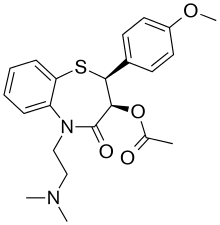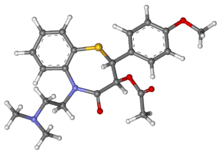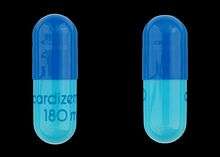Diltiazem
 | |
 | |
| Clinical data | |
|---|---|
| Trade names | Cardizem, Dilacorxr |
| AHFS/Drugs.com | Monograph |
| MedlinePlus | a684027 |
| Pregnancy category |
|
| Routes of administration | Oral |
| ATC code | |
| Legal status | |
| Legal status |
|
| Pharmacokinetic data | |
| Bioavailability | 40% |
| Metabolism | Hepatic |
| Biological half-life | 3–4.5 hours |
| Excretion |
Renal Biliary Lactic (in lactating females) |
| Identifiers | |
| |
| CAS Number | |
| PubChem CID | |
| IUPHAR/BPS | |
| DrugBank | |
| ChemSpider | |
| UNII | |
| KEGG | |
| ChEBI | |
| ChEMBL | |
| ECHA InfoCard | 100.050.707 |
| Chemical and physical data | |
| Formula | C22H26N2O4S |
| Molar mass | 414.519 g/mol |
| 3D model (JSmol) | |
| |
| |
| (verify) | |
Diltiazem (INN) (/dɪlˈtaɪəzɛm/) is a nondihydropyridine (non-DHP) calcium channel blocker used in the treatment of hypertension, angina pectoris, and some types of arrhythmia. It relaxes the smooth muscles in the walls of arteries, which opens (dilates) the arteries, allows blood to flow more easily, and lowers blood pressure. Additionally, it lowers blood pressure by acting on the heart itself to reduce the rate, strength, and conduction speed of each beat.
It is also used off-label as an effective preventive medication for migraine. It is a class 3 antianginal drug, and a class IV antiarrhythmic.
Diltiazem is metabolized by and acts as an inhibitor of the CYP3A4 enzyme which can cause it to interact with a variety of other medications.
Mechanism

Diltiazem is a potent vasodilator, increasing blood flow and variably decreasing the heart rate via strong depression of A-V node conduction. Its pharmacological activity is somewhat similar to verapamil, another nondihydropyridine (non-DHP) calcium channel blocker.[1] Chemically, it is based upon a 1,4-thiazepine ring, making it a benzothiazepine-type calcium channel blocker.
It is a vasodilator of coronary and peripheral vessels, which reduces peripheral resistance and afterload, though not as potent as the dihydropyridine (DHP) calcium channel blockers. This results in minimal reflexive sympathetic changes.
Diltiazem has negative inotropic, chronotropic, and dromotropic effects. This means diltiazem causes a decrease in heart muscle contractility – how strong the beat is, lowering of heart rate – due to slowing of the sinoatrial node, and a slowing of conduction through the atrioventricular node – increasing the time needed for each beat. Each of these effects results in reduced oxygen consumption by the heart, reducing angina symptoms. These effects also reduce blood pressure by causing less blood to be pumped out.
Nontherapeutic effects and toxicities
A reflex sympathetic response, caused by the peripheral dilation of vessels and the resulting drop in blood pressure, works to counteract the negative inotropic, chronotropic and dromotropic effects of diltiazem. Undesirable effects include hypotension, bradycardia, dizziness, and flushing.[2]
Indications
The drug is indicated for angina:
- Stable angina (exercise-induced) – diltiazem increases coronary blood flow and decreases myocardial oxygen consumption, secondary to decreased peripheral resistance, heart rate, and contractility.[3][4]
- Variant angina – it is effective owing to its direct effects on coronary dilation.
- Unstable angina (preinfarction, crescendo) – diltiazem may be particularly effective if the underlying mechanism is vasospasm.
For supraventricular tachycardias (PSVT), diltiazem appears to be as effective as verapamil in treating re-entrant supraventricular tachycardia.[5]
Atrial fibrillation[6] or atrial flutter is another indication. The initial bolus should be 0.25 mg/kg, intravenous (IV).
Because of its vasodilatory effects, diltiazem is useful for treating hypertension. Calcium channel blockers are well tolerated, and especially effective in treating low-renin hypertension.[7]
Contraindications and precautions
- In congestive heart failure, patients with reduced ventricular function may not be able to counteract the inotropic and chronotropic effects of diltiazem, the result being an even higher compromise of function.
- With SA node or AV conduction disturbances, the use of diltiazem should be avoided in patients with SA or AV nodal abnormalities, because of its negative chronotropic and dromotropic effects.
- Low blood pressure patients, with systolic blood pressures below 90 mm Hg, should not be treated with diltiazem.
- Diltiazem may paradoxically increase ventricular rate in patients with Wolff-Parkinson-White syndrome because of accessory conduction pathways.
Diltiazem is relatively contraindicated in the presence of sick sinus syndrome, atrioventricular node conduction disturbances, bradycardia, impaired left ventricle function, peripheral artery occlusive disease, and chronic obstructive pulmonary disease.
Drug interactions
Because of its inhibition of hepatic cytochromes CYP3A4, CYP2C9 and CYP2D6, there are a significant number of drug interactions, more than can be listed here.[8] Some of the more important interactions are listed below.
Beta-blockers
Intravenous diltiazem should be used with caution with beta-blockers because, while the combination is most potent at reducing heart rate, there are rare instances of dysrhythmia and AV node block.[9]
Quinidine
Quinidine should not be used concurrently with calcium channel blockers because of reduced clearance of both drugs and potential pharmacodynamic effects at the SA and AV nodes.[10]
Potential future indications
Diltiazem is prescribed off-label by doctors in the US for prophylaxis of cluster headaches. Some research on diltiazem and other calcium channel antagonists in the treatment and prophylaxis of migraine is ongoing.[3][11][12][13][14][15][16]
Recent research has shown diltiazem is able to reduce cocaine cravings in drug-addicted rats.[17] This is believed to be due to the effects of calcium blockers on dopaminergic and glutamatergic signaling in the brain.[18] Diltiazem also enhances the analgesic effect of morphine in animal tests, without increasing respiratory depression,[19] and reduces the development of tolerance.[20]
Diltiazem is also being used in the treatment of anal fissures. It can be taken orally or applied topically with increased effectiveness.[21] When applied topically, it is made into a cream form using either vaseline or Phlojel. Phlojel absorbs the diltiazem into the problem area better than the vaseline base. It has good short term success rates.[22][23] Like all nonsurgical treatments of anal fissure, it does not address the long term problem of increased basal anal tone and does not decrease the subsequent recurrence rate that can vary between 40 and 60%.
References
- ↑ O'Connor, Stephen E.; Grosset, Alain; Janiak, Philip (1999). "The pharmacological basis and pathophysiological significance of the heart rate-lowering property of diltiazem". Fundamental & Clinical Pharmacology. 13 (2): 145–53. PMID 10226758. doi:10.1111/j.1472-8206.1999.tb00333.x.
- ↑ Ramoska, E; Spiller, H; Winter, M; Borys, D (1993). "A one-year evaluation of calcium channel blocker overdoses: Toxicity and treatment". Annals of Emergency Medicine. 22 (2): 196–200. PMID 8427431. doi:10.1016/S0196-0644(05)80202-1.
- 1 2 Grossman, Ehud; Messerli, Franz H. (2004). "Calcium antagonists". Progress in Cardiovascular Diseases. 47 (1): 34–57. PMID 15517514. doi:10.1016/j.pcad.2004.04.006.
- ↑ Claas, Steven A; Glasser, Stephen P (2005). "Long-acting diltiazem HCL for the chronotherapeutic treatment of hypertension and chronic stable angina pectoris". Expert Opinion on Pharmacotherapy. 6 (5): 765–76. PMID 15934903. doi:10.1517/14656566.6.5.765.
- ↑ Gabrielli, Andrea; Gallagher, T. James; Caruso, Lawrence J.; Bennett, Neil T.; Layon, A. Joseph (2001). "Diltiazem to treat sinus tachycardia in critically ill patients: A four-year experience". Critical Care Medicine. 29 (10): 1874–79. PMID 11588443. doi:10.1097/00003246-200110000-00004.
- ↑ Wattanasuwan, N.; Khan, IA; Mehta, NJ; Arora, P; Singh, N; Vasavada, BC; Sacchi, TJ (2001). "Acute Ventricular Rate Control in Atrial Fibrillation : IV Combination of Diltiazem and Digoxin vs IV Diltiazem Alone". Chest. 119 (2): 502–06. PMID 11171729. doi:10.1378/chest.119.2.502.
- ↑ Basile, Jan (2004). "The Role of Existing and Newer Calcium Channel Blockers in the Treatment of Hypertension". The Journal of Clinical Hypertension. 6 (11): 621–29; quiz 630–1. doi:10.1111/j.1524-6175.2004.03683.x.
- ↑ Ohno, Y; Hisaka, A; Suzuki, H (2007). "General framework for the quantitative prediction of CYP3A4-mediated oral drug interactions based on the AUC increase by coadministration of standard drugs". Clinical pharmacokinetics. 46 (8): 681–96. PMID 17655375. doi:10.2165/00003088-200746080-00005.
- ↑ Edoute, Yeouda; Nagachandran, Pradeep; Svirski, Boris; Ben-Ami, Haim (2000). "Cardiovascular Adverse Drug Reaction Associated with Combined β-Adrenergic and Calcium Entry-Blocking Agents". Journal of Cardiovascular Pharmacology. 35 (4): 556–9. PMID 10774785. doi:10.1097/00005344-200004000-00007.
- ↑ Narimatsu, Akihiro; Norio Taira (August 1976). "Effects on Atrio-Ventricular Conduction of Calcium-Antagonistic Coronary Vasodilators, Local Anaesthetics and Quinidine Injected into the Posterior and the Anterior Septal Artery of the Atrio-Ventricular Node Preparation of the Dog". Archives of Pharmacology. 294 (2): 169–77. doi:10.1007/bf00507850.
- ↑ Montastruc, JL; Senard, JM (1992). "Médicaments anticalciques et prophylaxie de la migraine" [Calcium channel blockers and prevention of migraine]. Pathologie et Biologie (in French). 40 (4): 381–88. PMID 1353873.
- ↑ Kim, KE (1991). "Comparative clinical pharmacology of calcium channel blockers". American family physician. 43 (2): 583–88. PMID 1990741.
- ↑ Andersson, KE; Vinge, E (1990). "Beta-adrenoceptor blockers and calcium antagonists in the prophylaxis and treatment of migraine". Drugs. 39 (3): 355–73. PMID 1970289. doi:10.2165/00003495-199039030-00003.
- ↑ Paterna, S; Martino, SG; Campisi, D; Cascio Ingurgio, N; Marsala, BA (1990). "Evaluation of the effects of verapamil, flunarizine, diltiazem, nimodipine and placebo in the prevention of hemicrania. A double-blind randomized cross-over study". La Clinica terapeutica. 134 (2): 119–25. PMID 2147612.
- ↑ Smith, R; Schwartz, A (1984). "Diltiazem Prophylaxis in Refractory Migraine". New England Journal of Medicine. 310 (20): 1327–28. PMID 6144044. doi:10.1056/NEJM198405173102015.
- ↑ Peroutka, Stephen J. (1983). "The Pharmacology of Calcium Channel Antagonists: a Novel Class of Anti-migraine Agents?". Headache: the Journal of Head and Face Pain. 23 (6): 278–83. doi:10.1111/j.1526-4610.1983.hed2306278.x.
- ↑ Common Heart Drug May Reduce Cocaine Cravings. Sciencedaily.com (2008-02-28). Retrieved on 2012-10-21.
- ↑ Mills, K; Ansah, T; Ali, S; Mukherjee, S; Shockley, D (2007). "Augmented behavioral response and enhanced synaptosomal calcium transport induced by repeated cocaine administration are decreased by calcium channel blockers". Life Sciences. 81 (7): 600–08. PMC 2765982
 . PMID 17689567. doi:10.1016/j.lfs.2007.06.028.
. PMID 17689567. doi:10.1016/j.lfs.2007.06.028. - ↑ Kishioka, S; Ko, MC; Woods, JH (2000). "Diltiazem enhances the analgesic but not the respiratory depressant effects of morphine in rhesus monkeys". European Journal of Pharmacology. 397 (1): 85–92. PMID 10844102. doi:10.1016/S0014-2999(00)00248-X.
- ↑ Verma, V; Mediratta, PK; Sharma, KK (2001). "Potentiation of analgesia and reversal of tolerance to morphine by calcium channel blockers". Indian journal of experimental biology. 39 (7): 636–42. PMID 12019755.
- ↑ Jonas, Marion; Neal, Keith R.; Abercrombie, John F.; Scholefield, John H. (2001). "A randomized trial of oral vs. topical diltiazem for chronic anal fissures". Diseases of the Colon & Rectum. 44 (8): 1074–8. doi:10.1007/BF02234624.
- ↑ Nash, G. F.; Kapoor, K.; Saeb-Parsy, K.; Kunanadam, T.; Dawson, P. M. (2006). "The long-term results of diltiazem treatment for anal fissure". International Journal of Clinical Practice. 60 (11): 1411–13. PMID 16911570. doi:10.1111/j.1742-1241.2006.00895.x.
- ↑ Sajid, M. S.; Rimple, J.; Cheek, E.; Baig, M. K. (2007). "The efficacy of diltiazem and glyceryltrinitrate for the medical management of chronic anal fissure: a meta-analysis". International Journal of Colorectal Disease. 23 (1): 1–6. PMID 17846781. doi:10.1007/s00384-007-0384-x.